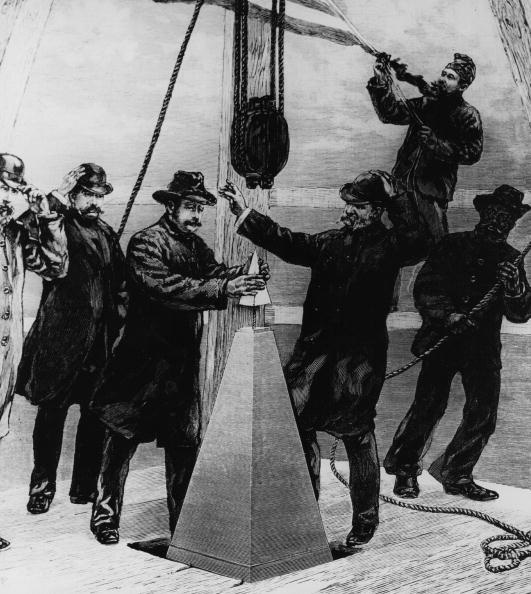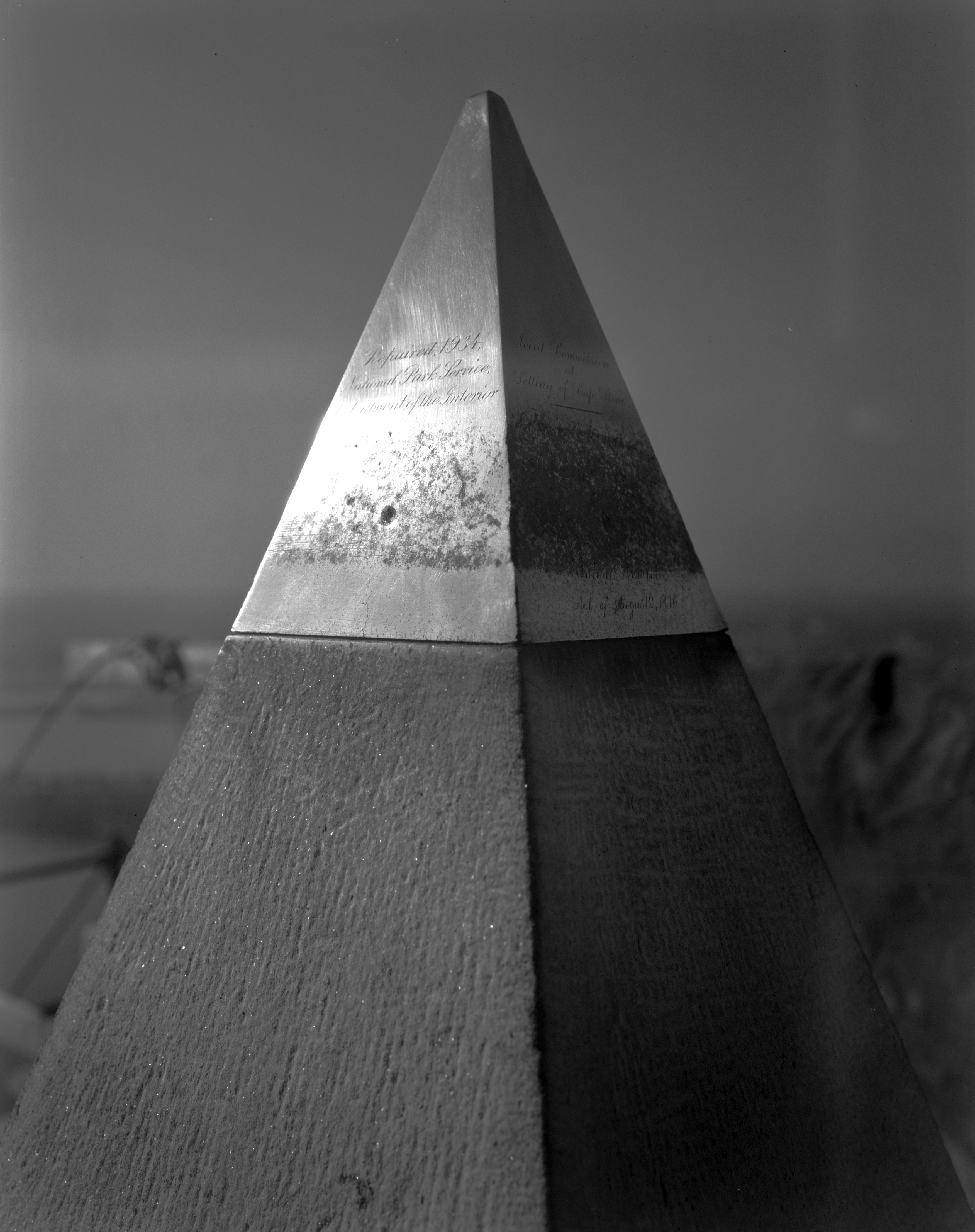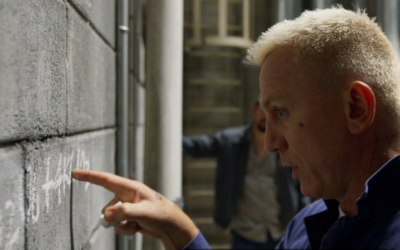
Spider-Man at the top of the Washington Monument. You can even see the inscriptions. (c) Sony/Marvel
It stands out in the Washington Monument scenes in Spider-Man: Homecoming.
It’s right there in the trailer and the movie – Spider-Man is at the top of the Washington Monument, and you can see it – the top is silvery gray.
What?
The top of the Washington Monument isn’t stone like the rest. It’s a pyramid of aluminum.
Why?
Chemistry.
Or rather, difficulties with chemistry.
It all goes back to when the Washington Monument was being built. The story of the monument’s plan, proposal and actual construction is a fascinating piece of history in and of itself, but we’re talking about the very top of the monument. Why is it a chunk of aluminum?
The apex piece of aluminum was placed on the top of the pyramidion on December 6th, 1884. Weighting 100 ounces (a little over six pounds), it was, at the time, the largest piece of aluminum that had ever been cast. Just prior to being placed on the top of the monument, the aluminum pyramid had been on display at Tiffany’s in New York, where it was on the floor of the store, and patrons were given the opportunity to “jump over the top of the Washington Monument.”
Stories persist to this day that aluminum was used solely because it was so expensive at the time of construction, and to put 100 ounces of it on top of a monument would be a sign of how important Washington was, as well as how prosperous a young America was as well.
That’s not entirely true, but has some pieces of truth in it.
At the time of the construction of the Washington Monument, pure aluminum cost about $1 an ounce, the same as silver. Thing was, silver could be mined from the ground. Pure aluminum had to be freed from its ore through a costly chemical process. As a result, only about 4 tons of pure aluminum (with only 112 pounds coming from the United States) was produced versus 2,834 tons of silver in 1884. So aluminum was scarce, but just because something is scarce doesn’t mean it’s in demand. Silver is a precious metal because it has high demand. Aluminum – not so much.
Where Did the Aluminum Come From?
Like all other matter on earth, the aluminum that was cast to top the Washington Monument came from the heart of stars, formed when hydrogen fuses with magnesium. Aluminum makes up 8.3% of the earth’s crust, but doesn’t appear by itself in nature like several other metals. Aluminum is found combined in oxides or silicates (it’s also found in turquoise, cryolite, ruby and sapphire among other minerals and gems). If you want to put aluminum on top of your monument in the late 1800s, you’re looking for the most common aluminum ore: bauxite.
The way aluminum was produced at the time of the monument’s construction involved a difficult chemical reaction wherein aluminum chloride (produced from the aluminum oxides of bauxite) was reduced by molten sodium:
AlCl3 + 3Na -> 2Al + 3NaCl
The method was costly and dangerous, and resulted in metal that was only 97% pure, making it difficult to work with. The cost and purity resulted in low demand for most of the 1800s. You could get aluminum if you wanted it, but it would cost you. That’s why you’ll sometimes see aluminum plates, silverware and jewelry from the 1800s in museum displays. For those who could afford it though (Napoleon was a fan), it showed off status.
By the 1880s, aluminum’s price per ounce had been hovering around $1 an ounce for about two decades, and that was directly related to the cost of refining it from its ore, rather than its demand. It had started to come down, thanks to cheaper methods for refining the sodium needed for the process.
This was the world in which the Washington Monument was being completed.
Capping the Monument
While there are loads of stories about why aluminum was used, it’s important to note that the metal wasn’t even the first choice for the pyramid at the top of the monument. Solid copper, bronze or platinum plated brass were the top choices for the pyramid, which would also serve as a lightning rod. The choice of aluminum came when the engineer in charge of completing the project, Colonel Thomas Lincoln Casey discussed the materials choices with William Frishmuth who owned a metal foundry in Philadelphia. Casey suggested his material choices, but in a series of letters, Frishmuth’s choice of aluminum was settled upon. Among the reasons, the gray of aluminum would blend in nicely with the granite, would not stain, and would polish well. Frishmuth’s quoted price: $75.
No cast of aluminum as large as the pyramid had ever been made. Frishmuth was forced to make an iron mold for the pyramid rather than sand, and encountered many difficulties through the two-week process, but finally completed the task in early November of 1884. Final price: $256.10. Casey was impressed with the quality – Frishmuth’s casting was of higher quality than had been produced to that point or for many decades afterwards, and eventually the parties settled on $225.
The aluminum pyramid was inscribed on site, and the Washington Monument was capped with the pyramid on December 6th, 1884.
And the whole country now knew what aluminum was. Which affected demand.
But it was still crazy difficult to pull out of its ore.
That was about to change.
But you knew that, right? Today, aluminum is everywhere, and it is extremely, to put it politely, cheap. Given the ubiquitous nature of aluminum in our world, it’s a safe bet that it doesn’t cost as much to produce any more.
Aluminum Goes Mainstream
The completion of the Washington Monument had many delays, but you could probably make a bet that if the capping of the monument had been delayed by a decade, the metal on the top wouldn’t have been aluminum. Putting it on the top of the monument was a comment on its properties as well as its value and symbolism. That value was about to take a hit.
Two years after the Washington Monument was capped with a little over six pounds of aluminum, a cheaper method for smelting aluminum was independently developed by two scientists, the American Charles Hall and the Frenchman Paul Heroult. The Hall-Herlout process used electrolysis to get the pure aluminum, and dissolved aluminum oxide in molten cryolite (Na3AlF6) which allowed for the process to operate at much lower temperatures. The new method follows the following reactions:
4Al(OH)3 → 2Al2O3 +6H2O
2Al2O3 + 3C → 4Al + 3CO2
Combining:
4Al(OH)3 + 2Al2O3 + 3C → 2Al2O3 + 6H2O + 3CO2.
The 2Al2O3 cancels out, leaving:
4Al(OH)3(s) + 3C(s) → 4Al(s) + 6H2O(g) + 3CO2(g)
The water is given off as steam.
But this wasn’t a chemical method. This new process, which the two men literally discovered within weeks of each other, utilized electrolysis.
Electrolysis involves putting two live electrodes into a liquid containing the material you’re trying to split into its parts. Positive ions will collect at the negative electrode (the cathode) while negative ions collect at the positive electrode (the anode). A common chemistry demonstration is the electrolysis of water – oxygen collects at the anode and hydrogen collects at the cathode. Collect the gasses and you’ll see that there’s twice as much hydrogen as there is oxygen, which you’d expect – water’s formula is H2O, after all. There’s two hydrogen atoms for every oxygen atom in a molecule of water.
Electrolysis had been tried earlier in the 1800s to purify aluminum, but the method was discarded for the cheaper chemical alternative. In the Hall-Heroult Method, aluminum (which has a +3 charge when it is liberated from its compound) gathers at the cathode, while oxygen and carbon gather at the anode. Also of note – the process gives off carbon dioxide. We’ll come back to that in a little bit.
The Hall-Heroult method was a terrific example of the nature of science. The two men, working independently, wouldn’t have been able to develop their process had it not been for other scientists working for years, trying to find an easier, and cheaper way to pull aluminum from its ore. Hall and Heroult were in the right place and time and asked the right questions.
The problems that affect the costs of the Hall-Heroult method started to diminish in the later 1800s as well. The electricity used to melt the cryolite and for electrolysis became cheaper thanks to better dynamos, Carl Josef Bayer invented a process by which bauxite could be easier refined to aluminum oxide, and Hall oversaw the scaling up of his process. Combined, the factors brought the price of aluminum down from $16 per pound in the mid-1800s to below $1 a pound by 1891, and by the time the Wright Brothers needed it to make a crankcase for their flyer, aluminum cost about $0.30 a pound.
Seven years after the capping of the Washington Monument with a six-pound chunk of aluminum, the cost of the metal in the cap was about $2.00.
In the 133 years since the aluminum cap has rested on the top of the Washington Monument, it has been hit by lightning countless times, blasting off small bits of aluminum while weathering and repairs have removed worn down some of the original inscriptions. For those who wish to see the apex pyramid up close, a replica is on display at the 490-foot level. The replica only shows the original inscriptions, not those made in 1934 when the Monument underwent repairs.
We can only assume that by grabbing on to the pyramid, Spider-Man helped along the weathering. Thanks, buddy.
One last cool aluminum fact – do you recycle your aluminum cans?
Seriously.
This isn’t any kind of touchy-feely warms hugs thing. The process by which aluminum is recycled is extremely cheap from an energy standpoint. Recycling aluminum from scrap involves melting the aluminum to allow any impurities to evaporate. That’s it. It takes significantly less energy to recycle aluminum than to extract aluminum from aluminum oxide via electrolysis – about 5%. This is a favorite question for AP Chemistry by the way – in fact, Sal Khan explains it rather well at Khan Academy.
And that aluminum can be recycled over and repeatedly. That Coke can next to you? There’s no way of knowing when that aluminum came out of the ground in its native bauxite, but it could easily be years if not decades old. And you can keep it in the chain.
Not to mention, the Hall-Heroult process produces a lot of carbon dioxide, about 12.7 tons CO2 per ton of aluminum.
Think next time you’re about to throw that aluminum can in the trash and find that recycling bin.
It’s what Spidey would want you to do.
By the way, despite what Spider-Man: Homecoming may have shown, the Washington Monument has been closed since August, 2016 and will remain closed until spring of 2019 in order to…modernize the elevator. Yeah – looks like it could use some help.
https://www.youtube.com/watch?v=sOe7NHfULD8









